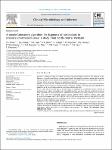



Objectives: Melioidosis may be endemic in many tropical developing countries, but diagnosis of the disease is currently unreliable in resource-limited areas. We aimed to validate a simple and cheap laboratory algorithm for the identification of Burkholderia pseudomallei from clinical specimens in parts of Vietnam where the disease has not previously been reported. Methods: In June 2015, we conducted training courses at five general hospitals in north-central provinces in order to raise awareness of the disease and to introduce a simple and cheap laboratory identification algorithm for B. pseudomallei including the three-antibiotic disc test. Results: Until the end of the year (7 months later), 94 suspected B. pseudomallei strains resistant to gentamicin and colistin but sensitive to amoxicillin/clavulanic acid were detected in clinical specimens from 70 patients. All strains were further confirmed as B. pseudomallei by using a specific TTSS1 real-time PCR assay and recA sequencing analysis. Among positive blood cultures, positive rates with B. pseudomallei ranged from 3.4% (5/147) to 10.2% (32/312) in the various clinics. A total of 82.8% (58/70) patients were bacteraemic, with a mortality of 50% (18/36) among patients with known outcome. No death occurred in nonbacteraemic patients. Conclusions: Our results demonstrate that the introduction of a simple and easy-to-perform laboratory algorithm for the identification of B. pseudomallei from clinical samples, together with clinical awareness raising, can lead to the diagnosis of a significant number of melioidosis cases in resource-limited clinical laboratories which previously did not identify the pathogen.
Bản đồ thống kê
Thống kê nội dung

Objectives: Melioidosis may be endemic in many tropical developing countries, but diagnosis of the disease is currently unreliable in resource-limited areas. We aimed to validate a simple and cheap laboratory algorithm for the identification of Burkholderia pseudomallei from clinical specimens in parts of Vietnam where the disease has not previously been reported. Methods: In June 2015, we conducted training courses at five general hospitals in north-central provinces in order to raise awareness of the disease and to introduce a simple and cheap laboratory identification algorithm for B. pseudomallei including the three-antibiotic disc test. Results: Until the end of the year (7 months later), 94 suspected B. pseudomallei strains resistant to gentamicin and colistin but sensitive to amoxicillin/clavulanic acid were detected in clinical specimens from 70 patients. All strains were further confirmed as B. pseudomallei by using a specific TTSS1 real-time PCR assay and recA sequencing analysis. Among positive blood cultures, positive rates with B. pseudomallei ranged from 3.4% (5/147) to 10.2% (32/312) in the various clinics. A total of 82.8% (58/70) patients were bacteraemic, with a mortality of 50% (18/36) among patients with known outcome. No death occurred in nonbacteraemic patients. Conclusions: Our results demonstrate that the introduction of a simple and easy-to-perform laboratory algorithm for the identification of B. pseudomallei from clinical samples, together with clinical awareness raising, can lead to the diagnosis of a significant number of melioidosis cases in resource-limited clinical laboratories which previously did not identify the pathogen.